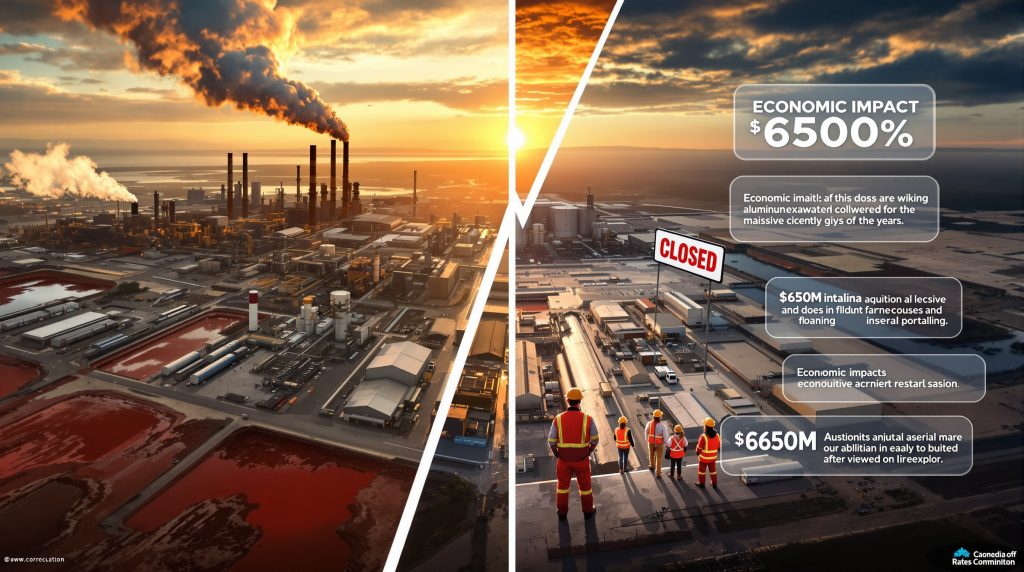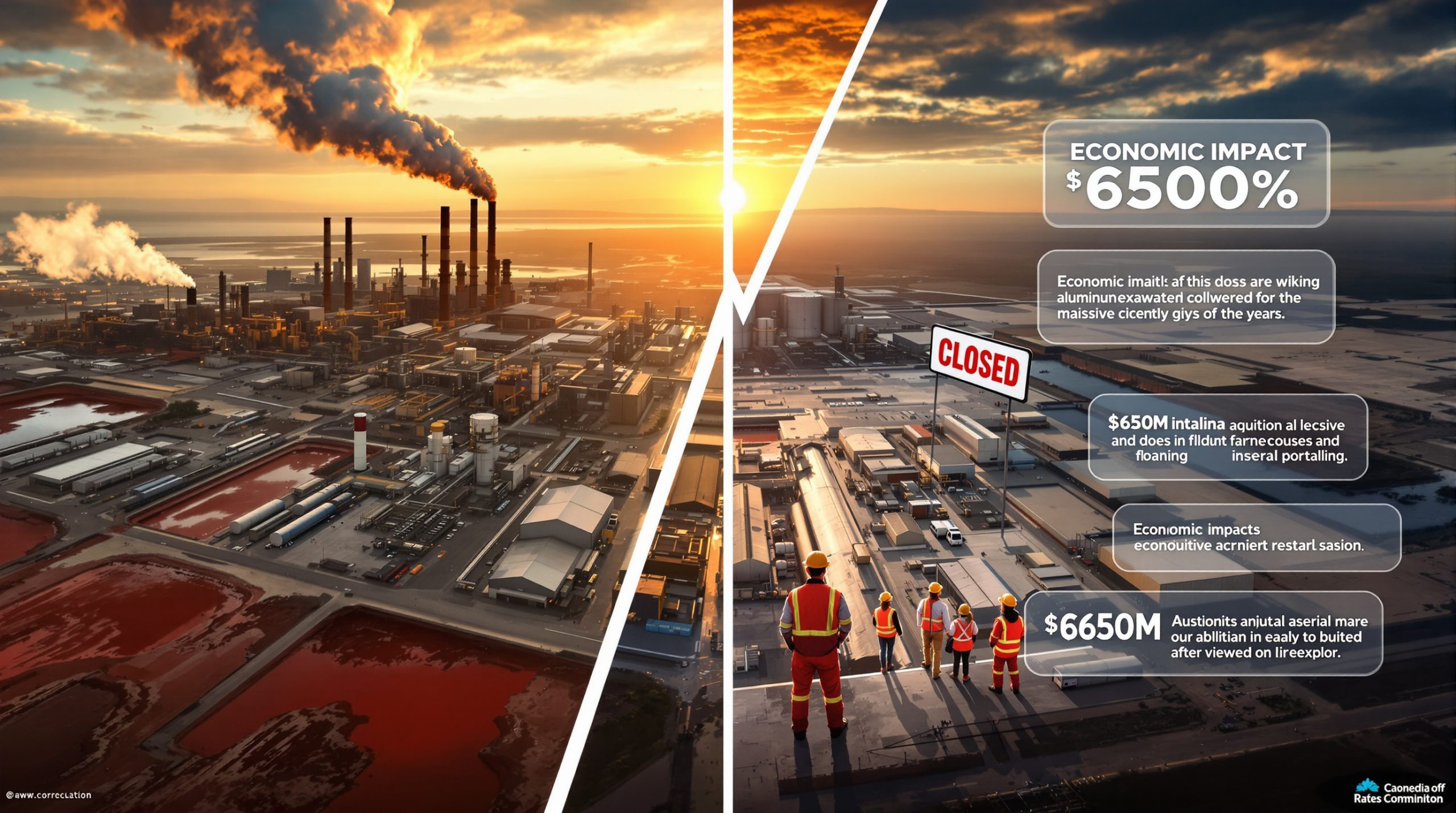Understanding the Kwinana Refinery Closure: Economic and Community Impacts
The Kwinana Alumina Refinery has been an industrial cornerstone in Western Australia since 1963, serving as the state's only independent alumina refinery for over six decades. Located south of Perth, this facility has transformed bauxite into alumina—the essential ingredient for aluminum production—while providing substantial employment and economic benefits to the region's southern suburbs.
As Alcoa announces the permanent closure of this historic facility, communities and policymakers are confronting significant economic, social, and environmental repercussions that will reshape Western Australia's industrial landscape for decades to come.
What is the Kwinana Alumina Refinery's historical significance?
The Kwinana Alumina Refinery began operations in 1963 during Australia's post-war industrial expansion, quickly becoming a pivotal asset in Western Australia's manufacturing sector. For more than 60 years, the facility has been the only independent alumina refinery in the state, playing a critical role in Australia's aluminum industry development.
The refinery's strategic location within the Kwinana Industrial Area—Western Australia's primary heavy industrial zone—allowed it to integrate with other industries and establish vital infrastructure connections. Over decades, the facility developed specialized expertise in the Bayer process, the principal method for refining bauxite ore into alumina through a complex chemical process involving crushing, digestion with sodium hydroxide, precipitation, and calcination.
Beyond its technical operations, the refinery became deeply woven into the social fabric of Perth's southern suburbs, creating generational employment and supporting numerous local businesses that formed around its operations. Many families in the area have multiple generations who worked at the facility, creating a unique industrial heritage that extends beyond economic impacts.
The refinery's footprint extends well beyond its immediate operations, with expansive residue storage areas containing decades of bauxite processing byproducts that will require ongoing environmental management long after production ceases.
How significant is the workforce impact of the closure?
Direct and indirect job losses
The Kwinana closure will eliminate approximately 220 direct jobs from Alcoa's workforce. This represents the final stage of a progressive reduction that began earlier in 2024, when the facility employed around 800 workers. Industry analysts estimate that for every direct job in heavy industry like aluminum processing, between 4-5 indirect jobs exist in the supply chain and supporting services.
This multiplier effect suggests the total employment impact could affect over 1,000 positions across Perth's southern metropolitan region. The specialized nature of many refining positions—including process technicians, chemical engineers, and specialized maintenance personnel—creates significant challenges for affected workers seeking comparable employment.
Many employees have developed skills specific to alumina refining that don't directly transfer to other industries, potentially forcing career changes or geographic relocation for continued employment in their field. The relatively high wages in the resources processing sector (averaging $120,000-150,000 annually for experienced technical roles) means many workers will face significant income reductions if transitioning to other industries.
Economic ripple effects
The refinery closure represents a substantial economic contraction for Western Australia's manufacturing sector. The estimated $650 million annual reduction in economic output will manifest through multiple channels:
- Reduced local procurement spending on maintenance services, equipment, and consumables
- Diminished household spending by former employees in local retail and service businesses
- Decreased tax contributions at local, state and federal levels
- Potential downward pressure on property values in surrounding suburbs
Local businesses with significant dependence on refinery operations—particularly specialized industrial service providers, maintenance contractors, and engineering firms—face existential challenges. Many small-to-medium enterprises with Alcoa as their primary client will need to rapidly diversify their customer base or face closure themselves.
The timing of the closure during a period of economic transition in Western Australia creates additional challenges, as other major employers in the resources sector are also implementing automation and efficiency measures that limit new job creation.
Why is Alcoa closing the Kwinana refinery?
Market and operational challenges
The Kwinana refinery faces multiple interlocking challenges that have eroded its competitive position in the global alumina market. The facility's 60+ year operating history brings inherent infrastructure limitations that newer facilities don't face. Aging equipment requires increasingly frequent maintenance interventions, driving higher operating costs compared to more modern operations.
Energy costs represent another critical factor. Alumina refining is energy-intensive, requiring significant thermal energy for the calcination process and electricity for operations. Western Australia's energy market has experienced volatility in recent years, particularly in natural gas prices, which directly impacts the refinery's cost structure. Modern refineries in regions with lower energy costs (particularly the Middle East and parts of Asia) maintain a structural cost advantage that Kwinana cannot overcome without massive capital investment.
Global alumina markets have become increasingly competitive, with substantial new capacity added in recent years, particularly in China and the Middle East. This capacity expansion has created periods of market oversupply, putting downward pressure on alumina prices and squeezing margins for higher-cost producers like Kwinana.
Financial implications for Alcoa
For Alcoa Corporation, the Kwinana closure represents part of a broader global restructuring strategy with significant financial implications. The company has disclosed restructuring costs exceeding $1.35 billion associated with its global optimization efforts, which include the Kwinana shutdown.
This substantial investment demonstrates the scale of Alcoa's transformation, as the company reduces its global refining capacity by 2.2 million metric tonnes annually. This capacity reduction allows Alcoa to focus resources on its more modern and efficient operations at Pinjarra and Wagerup refineries, which benefit from newer technology, more favorable cost structures, and greater operational flexibility.
The company will maintain certain strategic infrastructure at Kwinana, particularly port and rail operations that support its broader Western Australian network. These assets will continue supporting bauxite and alumina movements for Alcoa's remaining operations, optimizing the company's logistics capabilities while minimizing disruption to its overall supply chain.
Alcoa faces substantial ongoing costs beyond the immediate shutdown, particularly for environmental management of residue areas and site remediation. These long-term liabilities represent significant financial commitments extending decades beyond the operational closure.
What are the broader industrial implications?
Impact on Western Australia's aluminum industry
The Kwinana closure represents more than just the loss of a single facility—it signals a profound shift in Western Australia's industrial composition. As the state's only independent alumina refinery, Kwinana occupied a unique position in the value chain, with capabilities and technical expertise not replicated elsewhere in the region.
This closure raises fundamental questions about Australia's capacity to maintain downstream processing of its abundant natural resources. Despite being the world's largest bauxite producer, Australia has seen progressive contraction in its alumina and aluminum production capacity over the past two decades. This trend aligns with broader industry consolidation trends affecting many developed economies, where primary processing increasingly shifts to regions with lower operating costs.
The shutdown removes a significant industrial asset that has operated continuously since the 1960s, representing a substantial loss of institutional knowledge and specialized capabilities. The refinery's closure may accelerate the transition toward a more services-oriented economy in Western Australia, potentially reducing the state's manufacturing complexity and technological capabilities in heavy industry.
Environmental considerations
The refinery's environmental legacy will continue long after production ceases. Bauxite residue management represents the most significant long-term environmental challenge. These residue storage areas contain decades of accumulated "red mud"—the iron-oxide rich byproduct of the Bayer process—which requires ongoing monitoring and management.
Proper decommissioning involves complex environmental considerations beyond residue management, including potential soil contamination assessment, groundwater monitoring, and infrastructure remediation. The substantial scale of these environmental obligations adds significant costs to the closure process, with ongoing management requirements extending decades into the future.
While refinery operations will cease, environmental management commitments will continue, requiring dedicated resources and specialized expertise. Alcoa's management of these responsibilities will face ongoing regulatory oversight and community scrutiny, highlighting the lasting environmental footprint of alumina production even after operations end.
What has been the political and community response?
Political reactions
The Alcoa Kwinana refinery closure impact has triggered strong political responses across the spectrum. Western Australia's independent senator, Fatima Payman, expressed "deep concern" about the shutdown, emphasizing its profound community impact. Senator Payman highlighted how the refinery has been "a big part of WA's economy and the culture of the southern suburbs since the 1960s and its permanent loss will be felt heavily by the community."
Senator Payman has also raised broader questions about resource sovereignty, noting that "foreign companies like Alcoa dig out the resources that belong to West Aussies" while expressing concern that companies should prioritize "value-adding rather than cost-cutting." She plans to raise these issues during upcoming Senate Budget Estimates in Canberra.
The Nationals WA described the closure as a "devastating blow" to households and the regional economy, highlighting the broader implications for resource-dependent communities. This cross-party concern demonstrates the significant political implications of major industrial closures in regions heavily dependent on resource processing.
Other political stakeholders have emphasized the need for proactive government policies to support industrial competitiveness, including energy policy reforms, workforce transition programs, and potential incentives for maintaining value-added processing capabilities domestically.
Community concerns
Local communities face profound uncertainty following the closure announcement. Families dependent on refinery employment must navigate career transitions, potential relocation, and financial adjustments. Many workers have spent their entire careers at the facility, creating significant personal and professional disruption.
Community organizations have raised concerns about the broader social impacts, particularly the potential unraveling of community networks built around the refinery over generations. Local businesses anticipate reduced customer spending, creating a secondary wave of economic impacts throughout the region's commercial ecosystem.
Questions about site remediation and future land use have emerged as key community concerns. The substantial industrial footprint could potentially be repurposed for alternative economic activities, but uncertainty about timeline and development options creates community anxiety about extended vacancy and economic hollowing.
Calls for government intervention have intensified, with community groups advocating for coordinated transition planning that addresses both immediate worker displacement and longer-term regional economic diversification needs.
What does the future hold for the site and affected workers?
Transition planning
Alcoa has outlined a phased decommissioning process extending through 2026, allowing for systematic shutdown of operations while maintaining environmental controls and safety systems. This extended timeline provides some buffer for workforce transitions while ensuring proper deactivation of complex industrial processes.
Stakeholder engagement represents a critical component of the closure plan, with Alcoa committed to ongoing communication with employees, contractors, local government, and regulatory agencies. This consultation process aims to identify potential site redevelopment opportunities while ensuring safe closure procedures.
While most production assets will be decommissioned, certain strategic infrastructure will be retained, particularly port and rail connections that support Alcoa's broader Western Australian operations. This selective preservation of assets provides a foundation for potential future industrial activities that could leverage existing logistics capabilities.
The site's future utilization remains uncertain, with multiple redevelopment scenarios possible. Industrial brownfield sites of this scale typically require extensive remediation before repurposing, potentially limiting near-term redevelopment options. However, the site's strategic location within an established industrial area creates opportunities for compatible future uses once environmental requirements are satisfied.
Workforce transition challenges
Affected workers face significant transition challenges, particularly given the specialized nature of many refinery positions. Retraining programs represent a critical need, but must address the reality that many employees have developed highly specific technical skills with limited direct transferability to other sectors.
The geographic concentration of job losses creates additional challenges, as hundreds of specialized workers simultaneously seek new opportunities within a limited regional labor market. This situation may force difficult decisions about geographic relocation or career changes for many employees.
Some workers may find opportunities within other resources sectors, particularly mining operations that utilize similar process control technologies or maintenance disciplines. However, the ongoing trend toward automation and digitalization in these industries means total employment opportunities may be more limited than in previous mining expansion cycles.
Long-term economic diversification remains essential for the region's prosperity. Western Australia's historic reliance on resource extraction and processing creates vulnerability to commodity cycles and industry restructuring, highlighting the importance of developing more resilient and diversified economic foundations.
How does this closure reflect broader trends in Australian manufacturing?
Structural challenges in resource processing
The Kwinana shutdown exemplifies broader structural pressures affecting Australia's resource processing sector. Energy-intensive industries face particular challenges in the Australian context, where energy costs have risen significantly over the past decade. These cost pressures create competitive disadvantages compared to facilities in regions with lower energy prices, particularly the Middle East, Canada, and parts of Asia.
Australia's aging industrial infrastructure requires substantial reinvestment to maintain competitiveness, creating difficult capital allocation decisions for global companies with alternative investment opportunities in lower-cost regions. Many Australian processing facilities were established during earlier industrial eras with different cost structures and competitive dynamics, creating legacy challenges that newer facilities elsewhere don't face.
Global competition has intensified across the resources processing sector, with substantial new capacity developed in regions with structural advantages in energy costs, labor expenses, or proximity to growing markets. This expanded global capacity creates periodic oversupply conditions that put pressure on higher-cost producers like those in Australia.
These challenges extend beyond aluminum to other resource processing sectors, including steel, petrochemicals, and mineral processing, suggesting broader industry evolution trends rather than isolated facility decisions.
Strategic implications for Australia's resource sector
The Alcoa Kwinana refinery closure impact highlights fundamental tensions in Australia's resource development model. Despite being a global leader in resource extraction, Australia has struggled to maintain corresponding leadership in downstream processing and manufacturing. This creates an ongoing economic debate about the appropriate balance between extraction and value-added processing activities.
Questions about sovereign manufacturing capabilities have intensified, particularly given growing awareness of supply chain vulnerabilities highlighted during recent global disruptions. Critical minerals processing represents a particular focus, with growing recognition that Australia's abundant resources could support strategic industries if appropriate policy frameworks and investment incentives existed.
Government policy responses have evolved, with increasing emphasis on supporting domestic processing capabilities through various mechanisms, including potential concessional finance, co-investment models, and energy policy reforms. However, these measures face implementation challenges and competition with other policy priorities.
The ongoing debate about Australia's industrial future reflects differing perspectives on appropriate economic specialization in a globalized world. Some stakeholders advocate for focusing on Australia's comparative advantages in resource extraction, while others emphasize the importance of maintaining sophisticated manufacturing and processing capabilities for economic resilience and diversification.
What lessons can be learned from the Kwinana closure?
Industrial sustainability considerations
The Kwinana experience demonstrates the critical importance of continuous modernization and efficiency improvements for maintaining industrial competitiveness. Facilities that fall behind in technological upgrading face growing disadvantages that become increasingly difficult to overcome without massive capital reinvestment.
Energy policy emerges as a fundamental determinant of processing industry viability, particularly for energy-intensive operations like alumina refining. Nations seeking to maintain competitive resource processing sectors must develop coherent energy policies that balance environmental objectives with industrial competitiveness considerations.
The vulnerability of single-industry communities highlights the importance of economic diversification at local and regional levels. Regions heavily dependent on individual large employers face disproportionate impacts from industrial closures, emphasizing the value of fostering diverse economic activities that provide greater resilience against sector-specific disruptions.
Global competitiveness factors extend beyond direct operating costs to include broader considerations like regulatory frameworks, workforce capabilities, innovation ecosystems, and infrastructure quality. Maintaining manufacturing competitiveness requires coordinated approaches across these interdependent factors.
Policy implications
The Kwinana closure offers several policy lessons for governments navigating similar industrial transitions. Balancing environmental regulations with industrial competitiveness requires nuanced approaches that achieve environmental objectives while maintaining viable operating conditions for energy-intensive industries. This balance becomes increasingly challenging as environmental standards evolve and carbon constraints intensify.
Workforce transition support emerges as a critical policy need during major industrial restructuring. Effective transition programs must address both immediate displacement effects and longer-term structural changes in regional labor markets, requiring coordinated approaches across education, training, employment services, and regional development initiatives.
Value-added processing of Australian resources remains a contentious policy area, with ongoing debates about appropriate government interventions to encourage domestic processing versus allowing market forces to determine optimal supply chain configurations. The Kwinana case illustrates the complex interplay between corporate decision-making and government policy frameworks in shaping industrial outcomes.
Industrial site repurposing and remediation represents another policy challenge, requiring frameworks that facilitate productive reuse of industrial brownfields while ensuring appropriate environmental safeguards. The substantial scale and complexity of sites like Kwinana create particular challenges that may require innovative policy approaches and public-private partnerships to address effectively.
FAQs about the Kwinana refinery closure
What happens to the bauxite previously processed at Kwinana?
Alcoa plans to redistribute bauxite resources to its remaining Western Australian refineries at Pinjarra and Wagerup, which benefit from more modern facilities and improved efficiency. These operations can absorb some of the processing capacity previously handled at Kwinana, though overall alumina production in Western Australia will likely decrease. This redistribution allows Alcoa to optimize its integrated bauxite-alumina supply chain while concentrating operations at its most competitive facilities.
Will the entire Kwinana site be abandoned?
No, Alcoa will maintain strategic portions of the site's infrastructure, particularly port and rail connections that support its broader Western Australian operations. While production facilities will be decommissioned, these logistics assets will continue functioning as part of Alcoa's integrated supply chain. Additionally, environmental management activities will continue for decades, particularly for bauxite residue storage areas that require ongoing monitoring and maintenance. The company is also engaging with stakeholders regarding potential future site uses once decommissioning is complete.
How does this closure compare to other industrial shutdowns in Australia?
The Kwinana closure follows a pattern of manufacturing contractions affecting Australia's heavy industry sector over recent decades. Similar high-profile closures include the shutdown of automotive manufacturing operations by Ford, Holden, and Toyota between 2016-2017, the progressive reduction of steel manufacturing capacity, and contractions in petroleum refining operations nationwide. These patterns reflect common challenges in maintaining competitive manufacturing in high-cost environments with aging infrastructure. However, unlike some abrupt closures, Alcoa's phased approach provides somewhat more transition time for affected stakeholders.
What support is available for affected workers?
Workers affected by the closure can access various transition resources, though specific programs vary by individual circumstances. Standard redundancy provisions provide financial buffers based on length of service, while some employees may qualify for redeployment opportunities at other Alcoa operations in Western Australia. Government support typically includes access to employment services, retraining subsidies, and career transition counseling. Industry-specific initiatives may provide targeted assistance for workers with specialized skills seeking to transfer to adjacent sectors. However, the specialized nature of many refinery positions creates particular challenges for successful transitions to comparable roles.
What environmental challenges remain after closure?
The most significant environmental challenge involves long-term management of bauxite residue disposal areas, which contain decades of accumulated "red mud" byproducts. These areas require ongoing monitoring, maintenance, and environmental controls to prevent potential contamination issues. Additionally, the industrial site itself will need comprehensive assessment and potential remediation of soil and groundwater impacts from over 60 years of intensive industrial operations. These environmental responsibilities extend far beyond the operational closure, creating long-term management requirements that will continue for decades under regulatory oversight from Western Australia's environmental authorities.
Environmental and Social Responsibility Beyond Closure
While production activities will cease at Kwinana, environmental and social responsibilities continue long after the last alumina shipment. Proper site management during decommissioning and beyond represents a critical test of corporate responsibility that will be closely monitored by regulators, community stakeholders, and environmental advocates.
The refinery's closure marks not just an industrial transition but a community transformation that will reshape Perth's southern suburbs for generations. How this transition is managed—by the company, government agencies, and community institutions—will determine whether the closure represents simply an economic loss or potentially the beginning of new opportunities through thoughtful mine reclamation innovation and sustainable mining transformation with improved waste management solutions.
Ready to Stay Ahead of Major Mining Discoveries?
Discovery Alert's proprietary Discovery IQ model instantly notifies investors of significant ASX mineral discoveries, turning complex data into actionable insights for both traders and long-term investors. Visit the Discovery Alert discoveries page to understand the substantial returns that major mineral discoveries have historically generated and begin your 30-day free trial today.




